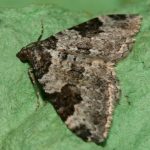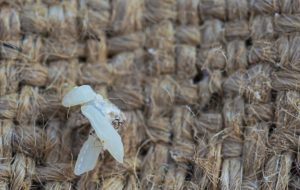
Carpet Moths in Melbourne
Carpet Moths are a textile pest. ‘Textile pests’ is a general term for insects who feed upon and damage stored clothing, carpeting, tapestries, or other fibre products. In practice, this includes various species of moths and beetles, the most common of which are the Clothes Moths and Carpet Beetles.
Textile pests are unusual in that they can digest the protein keratin which is the principal constituent of wool, animal hair and feathers and can be found in any textile of animal origin including mohair, silk, leather and feathers. Many of the textile pests are also pests of stored foodstuffs.
At least ten types of textile pests have been recorded in Australia. It is mainly the introduced species, which EPC – Enviro Pest Control commonly find in homes or businesses.
A common household pest, carpet moths can be a costly problem causing serious and often irreversible and expensive damage to textiles, including rugs and other soft furnishings in the home. Carpet moths often go unnoticed until the damage is caused, which is why it’s important that you know how to spot the signs and take preventative measures to avoid extensive damage to your home, business, or rental property.
It is actually the carpet moth’s larvae that causes the destruction, feeding predominantly on keratin found in natural fibres such as wool. The best way to combat carpet moths and textile pests is to prevent them from becoming established in the home or business.
- Carpet Moth or Tapestry Moth (Trichophaga tapetzetta)

- Is an introduced species
- This species is not as common as the casemaking clothes moth or the webbing clothes moth
- Its entire life cycle is similar to that of the casemaking clothes moth. The larvae prefer coarser and heavier fabrics than the other two species being commonly found in old woollens, horsehair, feltings, furs and feathers
- They construct burrows or silk-lined galleries in all directions throughout the infested materials
- The adult is larger than both the casemaking and webbing clothes moth, being approx. 8-12 mm long. The wingspan is up to 25 mm
- Adult Carpet Moth has wings that are dark brown at base fading to off white with variable brown markings
- Forewings are silvery-grey brown with 3 dark spots
- Dislikes light and frequents dark areas. Often scurries across surfaces instead of flying when disturbed
- Prefers undisturbed areas
Life cycle of Carpet Moths
- Carpet moths complete their cycles within a year and are more like webbing clothes moths in that they spin webbing in areas where they like to reside. Their speed of development depends entirely upon local temperature, humidity and food supplies
- The pupal case is spun of silk mixed with pieces of the larval food and is noticeably rough
- Females lay eggs in clusters of between 60 and 150
- Life cycle typically 3 – 8 months
- Larvae up to 12 mm long when full grown
- Larvae feed on animal skin, bird nests, pellets, fur, clothing and floor and furniture covering made of animal skin
- Cream caterpillar with dark brown head
Signs of Carpet Moth Infestation
EPC – Enviro Pest Control finds clients may have had an issue without noticing any signs. Moths prefer dark and undisturbed areas to lay their eggs. Additionally, the larvae take on the colour of the fibres they have eaten, making them very hard to spot. Signs of an infestation may include:
- Live moths flying around your business premise or home
- Adult moths present an obvious sign, despite the fact they do not do the damage, they have the potential to lay up to 150 eggs at a time
- Carpet Moths will thrive in dark, undisturbed areas, which can make them easier to go unnoticed
- Common locations to find them include under furniture, along baseboards and in rooms that are infrequently used

- Damage to rugs and carpets where fibres have become loose or noticeable threadbare patches
- Webbings or cocoons on clothes or carpets
- Damaged fibres on your carpets
- Finding tiny holes in any woollen, silk, or other material
- Half-eaten leather and feathers
- You may notice very small caterpillars crawling under your carpet or tiny cocoons that blend with your carpet
If you notice any insects or any signs of an infestation, take action quickly and call EPC – Enviro Pest Control to conduct an inspection of the area (03) 9988 5066
Prevention of Carpet Moths Infestations
- Ensuring you vacuum thoroughly around the edges of each room and under furniture is imperative
- Pay particular attention to low furniture such as beds, drawers and sideboards that go all the way to the floor but have a hollow space just above the carpet surface where they will lay their larvae which will eventually eat away the plie of the carpet
- Storing rolled up rugs or carpet off cuts can also attract carpet moth, so they should be checked regularly
Fun Facts about Carpet Moths
- The adult moths do not feed
- They are not attracted to light, and attempt to hide when disturbed
Why choose EPC – Enviro Pest Control?
If you live in Melbourne and have a carpet moth problem of any size, you should choose us to help you solve it because:
- EPC technicians are Trained Specialists and are very experienced at getting rid of carpet moths and textile pests
- We arrive on time
- EPC technicians are discreet, friendly and professionally presented
- Fairly priced service with advice to help prevent carpet moths coming back
- EPC pest control services including carpet moths are effective
Under the Residential Tenancies Act 1997, a tenant is required to advise their landlord or property manager of any issues that may cause damage to the property. This includes pests such as carpet moth and termites. EPC – Enviro Pest Control suggests providing your tenants with some basic information relating to the signs that these pests may be present.
If you have a textile pest infestation or even just want to prevent one, call us at EPC – Enviro Pest Control today on 03 9988 5066.
